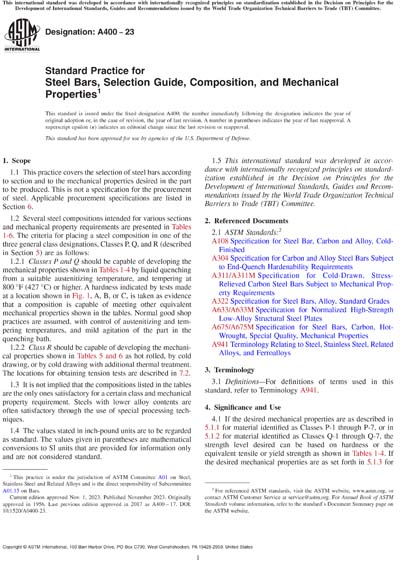Most recent
ASTM A400-23
Standard Practice for Steel Bars, Selection Guide, Composition, and Mechanical Properties
1.1 This practice covers the selection of steel bars according to section and to the mechanical properties desired in the part to be produced. This is not a specification for the procurement of steel. Applicable procurement specifications are listed in Section 6.
1.2 Several steel compositions intended for various sections and mechanical property requirements are presented in Tables 1-6. The criteria for placing a steel composition in one of the three general class designations, Classes P, Q, and R (described in Section 5) are as follows:
1.2.1 Classes P and Q should be capable of developing the mechanical properties shown in Tables 1-4 by liquid quenching from a suitable austenitizing temperature, and tempering at 800 °F (427 °C) or higher. A hardness indicated by tests made at a location shown in Fig. 1, A, B, or C, is taken as evidence that a composition is capable of meeting other equivalent mechanical properties shown in the tables. Normal good shop practices are assumed, with control of austenitizing and tempering temperatures, and mild agitation of the part in the quenching bath.
FIG. 1 Locations in Typical Cross Sections of Steel Bars at Which Desired Properties Are Obtained


1.2.2 Class R should be capable of developing the mechanical properties shown in Tables 5 and 6 as hot rolled, by cold drawing, or by cold drawing with additional thermal treatment. The locations for obtaining tension tests are described in 7.2.
1.3 It is not implied that the compositions listed in the tables are the only ones satisfactory for a certain class and mechanical property requirement. Steels with lower alloy contents are often satisfactory through the use of special processing techniques.
1.4 The values stated in inch-pound units are to be regarded as standard. The values given in parentheses are mathematical conversions to SI units that are provided for information only and are not considered standard.
1.5 This international standard was developed in accordance with internationally recognized principles on standardization established in the Decision on Principles for the Development of International Standards, Guides and Recommendations issued by the World Trade Organization Technical Barriers to Trade (TBT) Committee.
ASTM International [astm]

